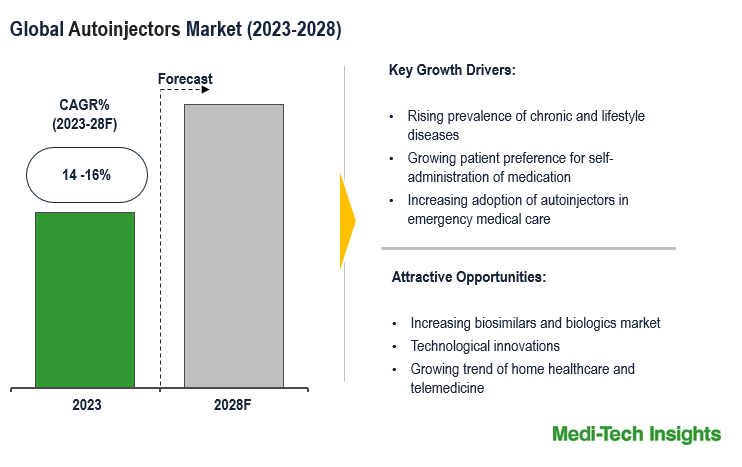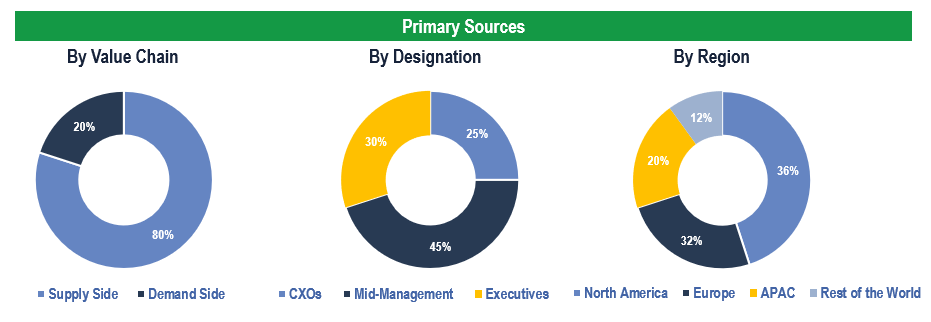
Autoinjectors Market Size, Revenue, Trends and Industry Demand from 2023 to 2028
The Autoinjectors Market is expected to witness a growth rate of 14-16% by 2028. The key factors driving the market are the rising incidence of chronic and lifestyle diseases, the rise in patient preference for self-administration of medication, technological advancements and the growing adoption of biosimilars and biologics which require frequent injections further driving the autoinjectors market. To learn more about the research report, fill out a quick inquiry for a sample report.
Autoinjectors are essential self-administered medical devices designed for subcutaneous or intramuscular drug delivery. Powered by a spring mechanism, these devices house pre-filled syringes or cartridges, providing advantages such as easy self-application, improved patient adherence, reduced anxiety, and precise dosage delivery. They are crucial for urgent interventions like anaphylaxis and chronic conditions such as psoriasis and rheumatoid arthritis. Autoinjectors are categorized based on function, with emergency types delivering life-saving drugs swiftly, and chronic therapy versions dispensing ongoing medications with features like dose adjustment or audio guidance. Activation mechanisms include push-on, spring-loaded, or button-activated options, each offering unique benefits. Additional features encompass single-use or multi-use designs, voice guidance, and temperature monitoring for optimal medication storage.
Patient-Centric Solutions: The Impact of Targeted Therapies and Generic Autoinjectors in the Global Market
Autoinjectors provide a convenient and user-friendly solution for patients requiring self-administration of medications. The ease of use and reduced potential for administration errors contribute to improved patient compliance, especially in the case of chronic diseases that require regular injections. The availability of generic autoinjectors introduces competition into the market, potentially leading to cost reductions. Generic versions of autoinjectors may offer a more affordable alternative for patients, promoting wider accessibility to these devices and boosting overall market growth. For instance,
- In July 2022, SHL Medical unveiled its plans to establish a new manufacturing facility in the United States, addressing the increasing market demand for its range of autoinjector products. This facility in South Carolina will cover an area of around 25,000 m2, with an initial investment of approximately US$ 90 million.
The rise in demand for targeted therapies, especially for conditions like autoimmune diseases, multiple sclerosis, and various chronic illnesses, has propelled the need for efficient drug delivery systems. Autoinjectors offer a user-friendly and precise method of administering targeted therapies, contributing to their increased adoption. Targeted therapies are often designed to address specific molecular or genetic factors associated with certain diseases. As the range of therapeutic areas benefiting from targeted treatments expands, the demand for autoinjectors grows accordingly. Additionally, the growing demand for targeted therapies has spurred technological advancements in autoinjector design and functionality. Manufacturers are incorporating innovations such as connected devices, smart features, and dose-tracking capabilities to enhance the overall user experience, further driving the market growth. For instance,
- In October 2022, Ypsomed introduced a new autoinjector platform called YpsoMate 5.5, designed for liquid medications with volumes ranging from 1.5 to 5.5 ml. This latest addition to the YpsoMate family facilitates the self-administration of larger volume medications, particularly beneficial for the treatment of conditions such as cancer, rare diseases, and autoimmune disorders

Fill out the "Quick Inquiry Form" to request a sample copy.
The Nexus of Demand: Autoinjectors, Diabetes, and Anaphylaxis in the Global Healthcare Landscape
The increasing incidences of diabetes and anaphylaxis, coupled with a growing patient preference for self-administered medication, are pivotal drivers behind the robust growth of the global autoinjector market. The surge in diabetes cases necessitates frequent insulin injections, and autoinjectors offer a user-friendly and efficient solution for patients to self-administer insulin, promoting better adherence to treatment plans. Similarly, the rising prevalence of anaphylaxis, triggered by various factors such as food allergies or insect stings, emphasizes the need for immediate intervention. Epinephrine autoinjectors, with their portable and rapid administration features, cater to individuals prone to anaphylactic episodes, fostering a sense of empowerment and prompt response.
The escalating preference among patients for self-administered medication aligns with the convenience and ease of use offered by autoinjectors. Patients, particularly those managing chronic conditions like diabetes or requiring swift intervention for anaphylaxis, appreciate the autonomy and reduced reliance on healthcare professionals for routine injections. For instance,
- In May 2022, the FDA approved Lilly's Mounjaro (tirzepatide) injection, marking the first GIP and GLP-1 receptor agonist exclusively designed for treating adults with type 2 diabetes. Mounjaro is conveniently administered through Lilly's established auto-injector pen, featuring a pre-attached, concealed needle, eliminating the need for patients to handle or see the needle directly
This shift in patient preference contributes significantly to the increasing adoption of autoinjectors worldwide. In essence, the global autoinjector market is propelled by the rising demand for convenient and patient-centric drug delivery solutions, especially in the context of prevalent conditions such as diabetes and anaphylaxis. The advantages of autoinjectors, including simplified administration and rapid medication delivery, align with the evolving needs and preferences of patients, driving the market's growth trajectory.
Autoinjectors Market: Challenges
The growth of the autoinjectors market is impeded by challenges, including the high production costs leading to elevated product prices, and regulatory hurdles due to stringent approval processes. Additionally, the autoinjector market contends with competition from alternative drug delivery methods, such as oral medications and traditional injections, influenced by varying patient preferences and medical conditions.
North America Accounts for the Largest Share of the Global Autoinjectors Market
The size of the market varies across regions, with typically more well-established services in developed countries. Within the global market, North America takes the lead, primarily, owing to the rising prevalence of chronic diseases, technologically advanced products, favourable government initiatives and the increasing preference for self-administered medications is a key driver behind the growing demand for autoinjectors in the region.
Meanwhile, the Asia-Pacific region is experiencing rapid expansion in the autoinjectors market, attributed to the rising aging population, increased awareness about the benefits of self-administration of medications, and growing healthcare infrastructure. Countries like India and China, offering lower manufacturing costs, have become significant production and supply hubs, fueling market growth.
Autoinjectors Market: Competitive Landscape
Some key players in the autoinjectors market are AbbVie Inc., Amgen Inc., Becton, Dickinson and Company (BD), Eli Lilly and Company, Johnson & Johnson, Viatris Inc., Novartis International AG, SHL Medical AG, Ypsomed Holding AG and Owen Mumford Ltd. among others.
Organic and Inorganic Growth Strategies Adopted by Players to Establish Their Foothold in the Market
Players operating in this market are adopting organic and inorganic growth strategies such as launching new products, acquiring related firms, and entering into collaborations to garner higher market share. For instance,
- In October 2023, SHL Medical launched a new webpage Molly Connected Cap, an intelligent add-on for the Molly modular platform autoinjector. The webpage streamlines information on Molly Connected Cap's features, including remote adherence monitoring, personalized patient programs, decentralized clinical trials, and value-based reimbursement strategies
- In May 2023, SHL Medical revealed a collaboration with MoonLake Immunotherapeutics, aimed at developing an autoinjector for clinical and potential commercial supply of MoonLake's Nanobody sonelokimab, utilizing SHL Medical's Molly® autoinjector technology
- In June 2022, Stevanato Group S.p.A. entered into an exclusive agreement with Owen Mumford Ltd. for the Aidaptus auto-injector. Under this agreement, Stevanato Group becomes the exclusive manufacturing partner for the Owen Mumford-designed auto-injector, responsible for molding components, providing final and sub-assembly equipment, and offering market-leading pre-filled syringes.
The Autoinjectors Market is expected to gain further momentum in the coming years due to the rise in the number of chronic and lifestyle diseases, technological innovations, an increase in the patient preference for self-administered medications, and aggressive organic and inorganic growth strategies followed by the players.
Key Strategic Questions Addressed
- What is the market size and forecast for the Global Autoinjectors Market?
- What are the historical, present, and forecasted market shares and growth rates of various segments and sub-segments of the Global Autoinjectors Market?
- How has COVID-19 impacted the Global Autoinjectors Market?
- What are the major growth drivers, restraints/challenges impacting the market?
- What are the opportunities prevailing in the market?
- What is the investment landscape?
- Which region has the highest share in the market? Which region is expected to witness the highest growth rate in the next 5 years?
- Who are the major players operating in the market? What is the competitive positioning of key players?
- Who are the new players entering the market?
- What are the key strategies adopted by players?
- Research Methodology
- Secondary Research
- Primary Research
- Market Estimation
- Market Forecasting
- Executive Summary
- Market Overview
- Market Dynamics
- Drivers
- Restraints
- Opportunities
- Market Dynamics
- Global Autoinjectors Market - By Type
- Disposable
- Reusable
- Global Autoinjectors Market – By Therapy
- Diabetes
- Rheumatoid Arthritis
- Anaphylaxis
- Other therapy areas
- Global Autoinjectors Market- By End User
- Hospitals
- Clinics
- Other End Users
- Global Autoinjectors Market - Size & Forecast (2019-2027), By Region
- North America (U.S. & Canada)
- Europe (UK, Germany, France, Italy, Spain, Rest of Europe)
- Asia Pacific (China, India, Japan, Rest of Asia Pacific)
- Rest of the World (Latin America, Middle East & Africa)
- Competitive Landscape
- Key Players and their Competitive Positioning
- Competitive Positioning of Key Players (2022)
- Offerings Assessment, By Players
- Key Strategies Assessment, By Player (2021-2023)
- New Product Launches
- Partnerships, Agreements, & Collaborations
- Mergers & Acquisitions
- Other Developments
- Key Players and their Competitive Positioning
- Key Companies Scanned (Indicative List)
- AbbVie Inc.
- Amgen Inc.
- Becton, Dickinson and Company (BD)
- Eli Lilly and Company
- Johnson & Johnson
- Viatris Inc.
- Novartis International AG
- SHL Medical AG
- Ypsomed Holding AG
- Owen Mumford Ltd
- Other Players
The study has been compiled based on extensive primary and secondary research.
Secondary Research (Indicative List)

Primary Research
To validate research findings (market size & forecasts, market segmentation, market dynamics, competitive landscape, key industry trends, etc.), extensive primary interviews were conducted with both supply and demand-side stakeholders.
Supply Side Stakeholders:
- Senior Management Level: CEOs, Presidents, Vice-Presidents, Directors, Chief Technology Officers, Chief Commercial Officers
- Mid-Management Level: Product Managers, Sales Managers, Brand Managers, Business Development Managers, Consultants
- Demand Side Stakeholders: Stakeholders in Hospitals, Clinics, and Other End Users
Breakdown of Primary Interviews

Market Size Estimation
Both ‘Top-Down and Bottom-Up Approaches’ were used to derive market size estimates and forecasts.
Data Triangulation
Research findings derived through secondary sources & and internal analysis were validated with Primary Interviews, Internal Knowledge Repository, and Company Sales Data.



